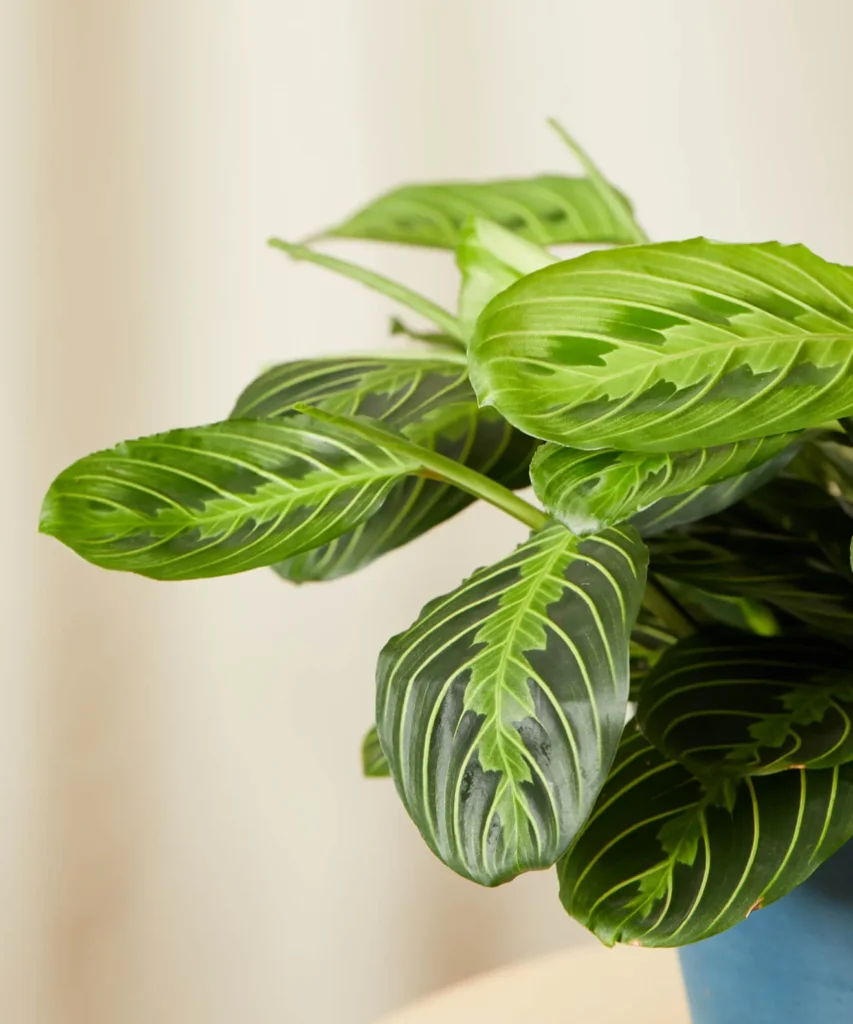Prayer Plant Care
Prayer Plants feature unique foliage with feathered, painterly-like veins. The bold foliage makes Prayer Plants perfect for window sills, mantles, or shelves that need a splash of color. Prayer Plants get their name from the way the leaves fold in the evening, resembling hands folded in prayer.

How to care for your Prayer Plant
- LIGHT
Your Prayer Plant prefers bright, indirect light. Direct sun can cause the leaves to fade and scorch.
- WATER
Water when the soil volume is 25% dry. Water until liquid flows through the drainage hole and discard any that accumulates in the saucer.
- HUMIDITY
This plant prefers above-average humidity. Use a pebble tray, place a humidifier nearby, or mist often.
- TEMPERATURE
Prayer Plants prefer temperatures between 68° – 85°F.
- FOOD
Feed once a month during the spring and summer with an all-purpose fertilizer for indoor plants. Never apply fertilizer to dry soil.
- TOXICITY
This plant is considered non-toxic and pet-friendly.
- ADDITIONAL CARE
You can prune your Prayer Plant to encourage full, vigorous growth. Use a sterilized pair of sharp scissors and clip the stems right above a leaf node. You’ll soon notice new growth emerging directly below the cut area.
Common Issues for your Prayer Plant
Incredibly dry soil
Your Prayer Plant prefers soil that is consistently moist. Be sure you’re not over or underwatering your plant. Keep a consistent watering schedule–water when 25% of the soil volume is dry.
If you accidentally let your Prayer Plant’s soil dry out completely, you may see leaves go limp, droop, and possibly start to brown and curl. If the soil is extremely dry all the way through the pot, a thorough soak is in order.
Here’s how to soak-water your Prayer Plant:
- Place your plant in your sink or tub without the saucer. Fill your basin up with about 3-4″ of water. Make sure the water isn’t hot!
- Allow your plant to soak up water through the drainage hole in the bottom of the pot for at least 45 min.
- Feel the top of the soil after your plant has been soaking–has the water reached the top 2-3” of soil?
- If not all the soil feels saturated, water your Prayer Plantslightly from the top of the soil to help speed up the saturation.
- When your plant’s soil is evenly damp, drain the sink/tub and allow the plant to rest while it drains thoroughly. Place the plant back on its saucer and back in its proper spot.
Water quality
If the curling continues after you’ve regulated a watering schedule, another common reason your Prayer Plant’s leaves are curling could be due to your tap water. Tap water contains salts, chlorine, minerals, and fluoride – all of which can build up in the soil of your plant causing the tips of the leaves to burn, turn brown, and curl up. One way you can remedy this is to use a water filtration system. If you do not have a filtration system available, leaving your water in an open container or sink overnight before using can help relieve some of the chlorine.
Temperature
Make sure your plant is not in a drafty area or in the path of heating and cooling vents. Leaves will curl if the plant is cold, or excessively dry from constant warm airflow.
Not enough humidity
Your Prayer Plant is a tropical plant, so it will thrive in more humid environments. Increase the humidity around your plant by misting the leaves on a regular basis, using a pebble tray, or moving a humidifier nearby.
New Growth
If you notice tight curling leaves, this may be normal. New growth forms as curled leaves that eventually unfurl into mature broad leaves.
Water Quality
Most often, yellowing leaves and spots on Prayer Plants are caused by a water quality issue. There may be too much fluoride, salt or chlorine in your tap water–especially if you use a water softener. Water your Prayer Plant with distilled water or leave a pitcher of tap water uncovered overnight so the minerals can evaporate before watering.
When you water your plant, make sure the water does not splash onto the leaves. Use lukewarm water and allow it to flow freely from the bottom of the pot into your sink or the plant’s saucer. Never allow any water to accumulate in the saucer; Prayer plants do not like “wet feet.” Water in the morning so the plant has the day hours to dry down a bit. Your plant should be placed in an area with bright indirect light until it recovers.
Fungus
If the yellow spots spread and become tan with yellow halos, fungus may have set in. An application of a general houseplant fungicide can kill active fungal disease and prevent future outbreaks. Follow the directions on the bottle carefully.
You can also make your own homemade fungicide with 1-2 tablespoons or of baking soda and 1-2 teaspoons of mineral oil in a spray bottle of water. Shake the solution well and then spray all areas of the plant that are infected. Repeat daily until no new spots appear.
